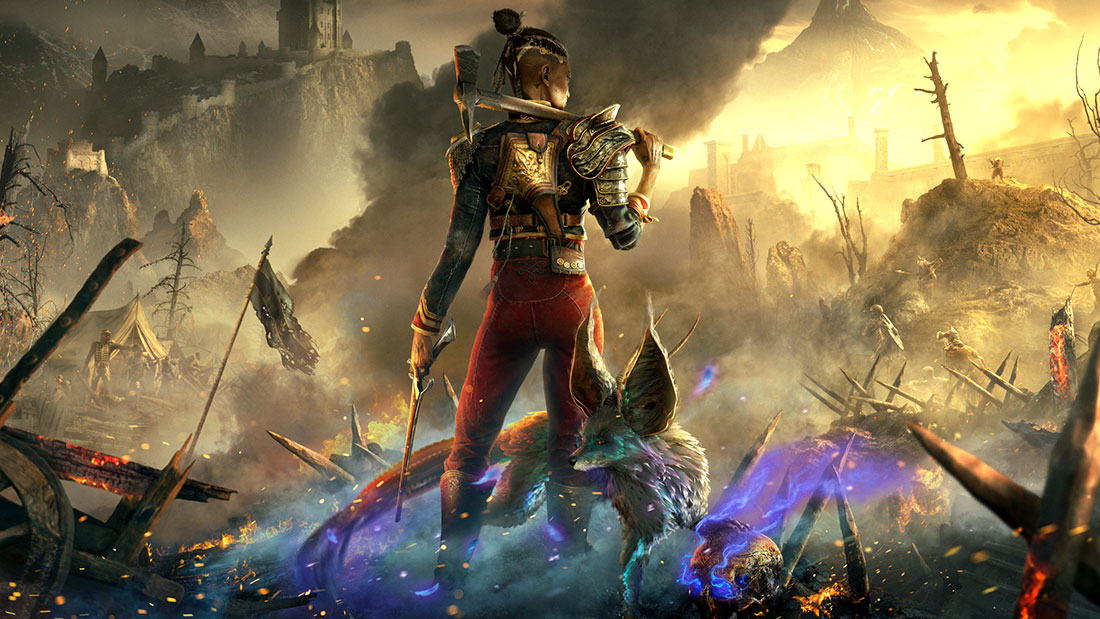Flintlock: The Siege of Dawn is the second release from A44 Games. It’s a AA title through and through, from its short runtime and abundance of familiar design elements, to the methodical combat system acting as centrepiece to a God of War style action-adventure.
Players are cast as a feisty sapper called Nor Vanek, who after a botched attempt at sealing the literal gates to the underworld, teams up with a deific fox called Enki to save humanity from extinction at the hands of malevolent gods and their undead armies. This plays out in typical fashion for a budget 3D action-adventure, with players traversing wide linear environments, unlocking shortcuts and hidden secrets, all the while slaying enemies to earn the reputation needed to upgrade their equipment and abilities.
Flintlock: The Siege of Dawn has much in common with Bloodborne and Sekiro: Shadows Die Twice, as players slash and shoot enemies with axes and firearms before executing well-timed parries and devastating riposte attacks that can kill smaller enemies in a single flashy strike. Sadly, Nor needs to be unnervingly close to enemies for her melee attacks to connect, which gets a tad frustrating during swarm encounters featuring everything from vicious zombies to overzealous highwaymen.
Enki doesn’t add much substance to brawling either. Like putting a pistol in the hands of Shadow the Hedgehog, Enki’s impact is limited to a single button press, as he marks enemies with a stagger gauge Nor can pressure for extra damage and other helpful effects. It’s nice, but couldn’t that gauge just be there anyway and save me from from pressing the same button three times before every combat? Things pick up when Nor gets rifles because even though bullets are scarce, sniping enemies (complete with slow motion cranium explosions) is the kind of evergreen video game thrill that’s hard to screw up. That is until enemies start wearing helmets, but the thought was nice!
What saves combat from being too frustrating is the smooth and customisable difficulty level. In fact, the hardest challenge at the default setting might just be remembering the elevation level of checkpoint icons on the map screen. Whereas Sekiro had a grappling hook to soar across terrain with ease, Nor has a jerky teleport gimmick to unlock shortcuts players won’t actually use much, so be prepared to spend considerable time (slowly) running everywhere regardless.
While the plot does move along at brisker pace, much of the story is told in a dour fashion. There’s little forward momentum despite the meaningful conflict at the centre of the action. Players must essentially defeat three big bosses across three different maps, with the final map being so small it doesn’t even contain any crafting materials to improve Nor’s gear. That’s a problem because players don’t have enough materials to upgrade every blade, gun, grenade, and armour piece Nor collects, so you ideally need to commit to an upgrade path early. Otherwise you’ll need to tediously scour previously visited areas for materials, so take note if you want to maximise Nor’s abilities before the end (and get that one annoying gear achievement).
The story goes full “AA” towards the end, too. All the side characters disappear and nothing exciting happens as players walk and talk through dreary ruins en route to the final boss. It would be easier to live with if the rest of the game was more fun, but alas the combat and exploration portions just aren’t good enough to compensate. It’s disappointing because A44 Games aren’t strangers to this genre, but then elements like the reputation system are so poorly conceived, it almost prompts the question of what went wrong?
Reputation is the experience players get from defeating enemies and completing side quests. The reputation paid out from combat starts low and multiplies if players mix up their offence and avoid getting hit. The points must then be banked when Nor isn’t being threatened, thus adding a risk-reward element to fighting. But it’s also an extremely fussy way to play because it requires extreme precision to avoid taking hits, especially when obscured ranged enemies can so easily damage you and destroy the earnings you worked so hard for. It’s feel-bad game design taken from Lords of The Fallen, of all things, and it works no better here than it did there a whole decade ago!
Reputation is further spoiled by players needing to recollect it from any spot Nor dies (lest they lose it permanently). These “corpse runs” have featured in video games as far back as the first text-based RPGs, but here the mechanic feels like it’s been implemented without much thought. Players are free to spend (and refund) reputation on Nor’s skills whenever they like, so carrying large sums of it around doesn’t create much tension unless the player is forgetful. Even so, forcing players to do this when they’re already navigating large maps and a punishing combo system in a relatively short campaign setting, contributes nothing positive to the gameplay experience. Corpse runs are just an annoying time sink here, aggravating an upgrade economy that’s already so strict and grindy, players must choose between changing Nor’s outfit and upgrading the skills she needs to survive!
Ultimately though, Flintlock: The Siege of Dawn’s overriding problem is just that it’s extremely bland and rarely all that enjoyable. At every turn it feels like something I’ve played before — a cheap and not so cheerful experience aiming for narrative stakes too epic for something of such limited scope and originality.
Flintlock: The Siege of Dawn on Steam »






Leave A Comment